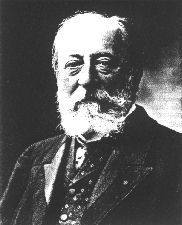Camille Saint-Saëns (1835-1921)
(born Paris, 9 October 1835; died Algiers, 16 December 1921).

Showing Mozartian precocity as both a pianist and composer, he had
childhood lessons with Stamaty and Boëly before entering the Conservatoire
(1848), where Halévy was his teacher; his dazzling gifts early won
him the admiration of Gounod, Rossini,
Berlioz
and especially Liszt,
who
hailed him as the world's greatest organist. He was organist at
the Madeleine, 1857-75, and a teacher at the Ecole Niedermeyer, 1861-5,
where Fauré was among
his devoted pupils. With only these professional appointments, he
pursued a range of other activities, organizing concerts of Liszt's
symphonic poems (then
a novelty), reviving interest in older music (notably of
Bach,
Handel
and Rameau), writing on musical, scientific and
historical topics, travelling often and widely (in Europe, North Africa
and South America) and composing prolifically; on behalf of new French
music he co-founded the Société Nationale
de Musique (1871). A virtuoso pianist,
he excelled in Mozart and was praised for the
purity and grace of his playing. Similarly French characteristics of his
conservative
musical style - neat proportions, clarity, polished expression, elegant
line - reside in his best compositions, the classically
orientated sonatas
(especially the first each for violin and cello), chamber
music (Piano Quartet op.41),
symphonies (no.3, the 'Organ'
Symphony, 1886) and concertos
(no.4 for piano, no.3 for violin). He also wrote 'exotic', descriptive
or dramatic works, including four symphonic
poems, in a style influenced by Liszt,
using thematic transformation, and 13 operas, of which only "Samson
et Dalila" (1877), with its sound structures, clear declamation
and strongly appealing scenes, has held the stage. "Le
carnaval des animaux" (1886) is a witty frolic; he forbade performances
in his lifetime, 'Le cygne' apart. From the mid-1890s he adopted a more
austere style, emphasizing the classical aspect of his aesthetic which,
perhaps more than the music itself influenced Fauré
and Ravel.
